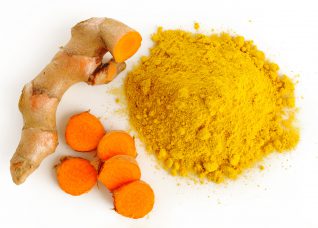
MinerAlert

MinerAlert
Curcuma longa
Zingiberaceae
Haridraa, haldi, halood, nuhna, ro miet, jiang huang
 .
.Turmeric grows in various parts of Asia including India, Cambodia, China, and Malesia (Quattrocchi, 2012).
Turmeric is a plant whose underground stems (rhizomes) have been utilized for many centuries (alone or in combination worth other plants) in India and other parts of Asia as a spice, medicine, and natural yellow-orange food coloring (Bandyopadhyay, 2014; Quattrocchi, 2012; Gupta et al., 2013).
Its traditional use as herbal medicine in Ayurveda, Siddha, and Unani medicine of India has been to treat a plethora of ailments including asthma, inflammation, liver and gall bladder disorders, dyspepsia, peptic ulcers, infections, fungal infections (mycoses), wounds, and skin diseases. The rhizomes are also used against intestinal parasites, amenorrhea (absence of menstruation), cholera, and jaundice (Khare, 2007, 2004; Tang and Eisenbrand, 2011; Sivarajan and Balanchandran, 1994).
Turmeric flowers are taken as a tea to lower fevers. A paste made from the flowers is applied topically to treat ringworm, gonorrhea, and parasitic skin diseases (Quattrocchi, 2012).
The curcuminoids contained in the rhizome, which give the yellow color to turmeric, are composed of a mixture of curcumin (also known as diferuloylmethane, Natural Yellow 3, and E100), demethoxycurcumin, and bisdemethoxycurcumin. Curcumin comprises approximately 90% of the total content of the curcuminoids present in the rhizome (Chaudhari et al., 2015).
Curcumin has been found to possess various beneficial health effects including antimicrobial, anti-inflammatory, antioxidant, antiviral, and antiangiogenic (prevents the formation of new blood vessels in tumors). Additionally, it may protect against neurodegenerative disorders such as Alzheimer’s disease, and has hypoglycemic (antidiabetic) effects. One of the most salient features of this phytochemical compound is that it possesses powerful antitumor activities; it prevents tumor invasion and metastasis in a number of animal models, including models of lung, liver, stomach, colon, breast, and esophageal cancer, among others (Bandyopadhyay, 2014; Tang and Eisenbrand, 2011) Chaithongyot et al. (2015) reported that one of the various phytochemicals found in the turmeric rhizome, Curcuma C20-dialdehyde, could be a potential antineoplastic (anticancer) agent for chemotherapy and/or chemoprevention of both colon as well as cervical cancer.
A study assessed the possible synergistic (combination) effect of curcumin and an antitumor compound known as ABT-737. The results indicated that the combination of curcumin and ABT 737 can effectively induce the death of hepatocellular carcinoma (HCC) cells by inducing programmed celled death (apoptosis), and may offer a potential treatment strategy for patients with HCC (Zheng et al., 2015).
Invasive mycoses (fungal infections) can be an important complication related to some forms of cancer, since they can be a major cause of morbidity and mortality in patients suffering from this disease. Curcumin has a powerful antifungal effect against diverse strains of Candida, Cryptococcus, Aspergillus, Trichosporon and Paracoccidioides. Additionally, curcumin possesses a very good safety profile even at large doses. For these reasons, more research with turmeric and its main component, curcumin is expected to lead to clinical trials, as well as to improve the survival rate from fungal infections among cancer patients (Chen et al., 2015).
Studies have found that curcumin possesses both spermicidal as well as broad-spectrum antimicrobial activity against various species of bacteria and yeast that cause vaginal infections. For these reasons, curcumin may offer an innovative, non-steroidal contraceptive that has both spermicidal as well as antimicrobial activities for the treatment of many gynecological diseases, including cancer (Naz et al., 2016; Naz and Lough, 2014).
A review by Chaudhari et al. (2015) found that curcumin possess various valuable anti-inflammatory properties that can employed for the treatment of diverse skin conditions. However, possible allergic reactions (contact allergies) may occur in susceptible people, although more controlled studies with turmeric are needed in order to ascertain this.
Before you decide to take any medicinal herb or herbal supplement, be sure to consult with a health care professional first. Avoid self-medication and self-diagnosis: Always be on the safe side!
Bandyopadhyay D. Farmer to pharmacist: curcumin as an anti-invasive and antimetastatic agent for the treatment of cancer. Front Chem. 2014;2:113. doi: 10.3389/fchem.2014.00113.
Chaithongyot S, Asgar A, Senawong G, Yowapuy A, Lattmann E, Sattayasai N, Senawong T. Anticancer Effects of Curcuma C20-Dialdehyde against Colon and Cervical Cancer Cell Lines. Asian Pac J Cancer Prev. 2015; 16(15):6513-9.
Chaudhari SP, Tam AY, Barr JA. Curcumin: A Contact Allergen.
J Clin Aesthet Dermatol. 2015; 8(11):43-8.
Chen J, He ZM, Wang FL, Zhang ZS, Liu XZ, Zhai DD, Chen WD. Curcumin and its promise as an anticancer drug: An analysis of its anticancer and antifungal effects in cancer and associated complications from invasive fungal infections. Eur J Pharmacol. 2015 Dec 23. pii: S0014-2999(15)30435-0. doi: 10.1016/j.ejphar; 2015.12.038.
Gardner Z, McGuffin M (Editors). Botanical Safety Handbook 2nd ed.
Boca Raton, FL; CRC Press; 2013; pp.290-295.
Gupta SC, Sung B, Kim JH, Prasad S, Li S, Aggarwal BB. Multitargeting by turmeric, the golden spice: From kitchen to clinic. Mol Nutr Food Res. 2013; 57(9):1510-28. doi: 10.1002/mnfr.201100741.
Khare C P. Indian Medicinal Plants: An Illustrated Dictionary.
New Delhi, India: Springer-Verlag; 2007; pp. 717-719.
Khare C P. Indian Herbal Remedies.
Berlin: Springer-Verlag; 2004; pp. 479-483
Naz RK, Lough ML. Curcumin as a potential non-steroidal contraceptive with spermicidal and microbicidal properties. Eur J Obstet Gynecol Reprod Biol. 2014;176:142-8. doi: 10.1016/j.ejogrb.2014.01.024.
Naz RK, Lough ML, Barthelmess EK. Curcumin: a novel non-steroidal contraceptive with antimicrobial properties. Front Biosci (Elite Ed). 2016;1;8:113-28.
Quattrocchi, U. World Dictionary of Medicinal and Poisonous Plants (4 vols.).
Boca Raton, FL: CRC Press; 2012; pp; 542-544.
Sivarajan V, Balanchandran I. Ayurvedic Drugs and Their Plant Sources.
New Delhi: Oxford & IBH Publishing; 1994; pp. 169-171.
Tang W, Eisenbrand G. Handbook of Chinese Medicinal Plants Vol. 1.
New York: Wiley; 2011; pp.435-447.
Zheng R, You Z, Jia J, Lin S, Han S, Liu A, Long H, Wang S. Curcumin enhances the antitumor effect of ABT-737 via activation of the ROS-ASK1-JNK pathway in hepatocellular carcinoma cells.Mol Med Rep. 2015. doi: 10.3892/mmr. 2015.4715. [Epub ahead of print]